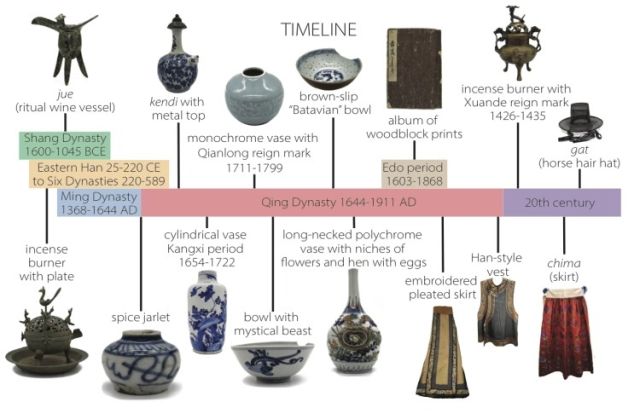Preview

Photo Credit
Laurel Lamb, Curator, University of Arkansas Museum
Object Date
Qing (1644-1912) to modern-period China
Object Type
Silk with cotton or linden band
Date
Spring 2020
Description
This embroidered, pleated skirt from the same donor as the Han-style vest, was also made in the Qing dynasty. Designed within cultural boundaries, this skirt expresses meaning established across place and time. The style of this skirt is referred to as an apron with two identical decorated panels, which when wrapped and overlapped, fall at the center in the front and back. The side pleating is narrow, deep, and even, hanging in meticulously regular, sharp folds from waist to hem. The pleated areas of the skirt (other than the hem) are undecorated except for the subtle damask pattern in the ground silk. The group of narrow pleats suggests receding layers, set off by embroidered bands at the edge of each group. Where the pleats are wide, they are set off by an applied border. Multiple embroidered strips and panels, interspersed with ribbon, are meticulously stitched to the ground, and to each other, to form repeating layers of decoration. Swimming through the embroidered border are symbols of the Flowers of the Four Seasons, such as the narcissus. The narcissus represents the twelfth month. It is known in Chinese as shuixian meaning ‘water fairy’ or ‘fairy of the waves’, symbolizing good fortune and prosperity. It is one of the most popular flowers of the Lunar New Year Festival. Blue orchids also fill the decorative band. Orchids are noted not only for their exquisite delicacy, but also for their sweet and pleasant fragrance. This skirt also incorporates symbols from the Eight Buddhist Emblems of Good Fortune, such as the endless knot toward the top left, which represents the love of the Buddha; the sheltering canopy, the fish of abundance, and the pure lotus flower. As for the thick gold-threaded clouds, these are symbols of peace and good fortune. Some of the flowing sashes of gold take the form of others symbols of wealth and fortune, such as the Ruyi Sceptre, which symbolizes “good wishes for a long life as all you wish” and resembles the “fungus of longevity” or lingzhi.. This symbol repeats, independently, as an applied design in black, above a solid wide strip of black, inside the side pleats. The placement of each border or edging affects not only the way the skirt looks, but also the way it moves. The trim stitched at regular intervals from the edge of each narrow pleat would maintain the rigid lines of the skirt and allow the pleats to move independently, as opposed to in a ripple effect. The skirt would be worn with the panels overlapping, wrapped around the body and through fabric loops and knotted buttons to make sure it stays securely closed. The wide waistband of the skirt is made of cotton or hemp which would help prevent the silken skirt from slipping off.
Object Housed
University of Arkansas Museum
Object Accession Number
0085-0044-0003 a or b


